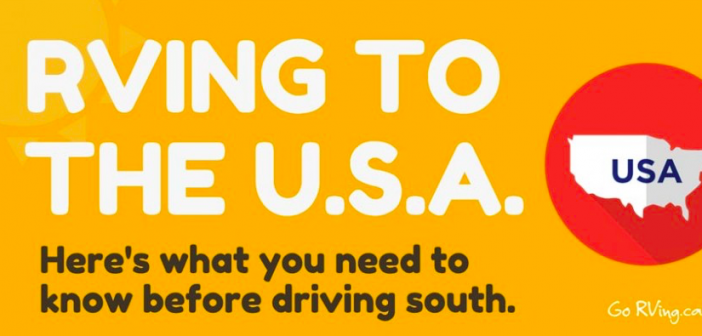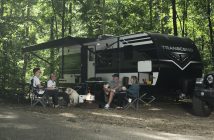Here’s what you need to know before driving south GoRVing.ca
America’s southern states offer warm escapes that typical Canadian winters, unfortunately, cannot compete with. When the thermometer starts to drop and the snow starts to fall, those of us who can tend to pack up our RVs to migrate south for the winter. Recent numbers suggest that about 500,000 Canadian snowbirds flock south each winter. Other studies show that Florida is the most popular destination for longer vacations.
However, travelling south of the border is a bit riskier than homeland Canadian adventures. There’s just a few extra steps to take before it’s time to hit the open road. Things like health insurance, what to bring, the length of your stay, and the duration of your stay are best planned before you meet with border control.
All of the planning can be a bit overwhelming. We want your RV trip to the United States to be filled with sunshine and open roads! Luck for you, we’ve compiled a list of the most important things you should know before migrating south. We promise, you’ll be soaking up Florida’s sunshine in no time.
1. What you can and cannot take with you.
Border control is strict, and there’s nothing worse than being pulled aside for a full scan of your rig. Really, it’s a pain! When you’re packing up your RV camper, be sure to double check the items that you can and cannot take with you. Careful preparation will help you answer all the usual questions at the border. Think of border control like airport security: proper packing promises a smooth passage south.
First off, food is a tricky topic. The meats and produce which are allowed across the border varies each season, and is based on a range of factors.
In terms of cash, don’t have more than $10,000 on hand. If you’re worried about budgeting, there are ways to save that don’t involve extreme amounts of cash. Some Canadian travellers like to switch credit card providers to find the best foreign rates for the duration of their RV getaway. As for those of you who enjoy hunting, there are special rules to follow in terms of transporting firearms. These rules vary depending on which states you plan to visit on route to your sunny southern destination.
2. Pack all of the necessary documents.
Passports are obvious, but have you thought about your pooch’s veterinary paperwork? Animals crossing the border require proof of vaccinations, and sometimes recent signed documents from veterinarians themselves.
Another piece of paperwork to check off your list is health insurance for yourself, as well as any necessary medications with prescriptions to match. Do you plan to stay in the south for an extended period of time? It’s better to pack extra of your necessary medications if possible, rather than negotiating with foreign doctors.
When we say documents, we mean more than just those that cover your health. Regular RV road trippers know to confirm their car insurance coverage before travelling to the United States. A CAA membership card may also be beneficial. Their coverage follows you into the United States, should you experience unexpected rig trouble. If you have all of the necessary documentation ready to go before border patrol asks, your passage south should be nothing but smooth sailing.
3. Plan your route, but don’t always follow it.
Whether you’re a young family who wants to take the kids on a trip before they start school, or a retired couple hoping to join other snowbirds in Florida, we want your trip to be nothing but fun! You’ve been planning your perfect RV trip south for months now. You’ve picked all of the best campgrounds to stop at along the way, and you’re ready to hit the road right on schedule. While it’s beneficial to be prepared, it’s also fun to follow the promise of adventure.
We advise that you give yourself a little leeway in your plans—some wiggle room in case you find a spot that you just must enjoy for one more night. Talk to other travellers you meet on the road. They always have the best recommendations! Research optional stops between the must-sees, both for added enjoyment and as back-up plans if some days on the road feel a little too tough. Trust us: you will want to have options to get out and stretch your legs!
4. How long do you plan to stay in the USA?
Snowbirds, rejoice! Canadians can stay as visitors in the US for up to 182 days per year—that’s about 6 months of sunshine and travel time south of the border. However, if you plan on travelling to the USA for 6 months out of the year, 3 years in a row, you will have to complete extra paperwork. The same applies to those hoping to stay longer than 6 months in a single calendar year.
The Entry-Exit Initiative keeps an eye on all travellers moving between Canada and the USA. All of these rules can get a little sticky. Stay informed with Canada’s snowbird laws and visit resources such as the Canadian Snowbird Association.
5. Enjoy the ride!
So many of us breeze through the drive to arrive at our sunny destinations as quickly as possible. The adventure is in the journey, too! Why bother rushing to the end? Florida isn’t going anywhere! The northern states offer beautiful scenery—different than the sunny beaches of Florida, but no less amazing.
Are you waving goodbye to Canada from our west coast? Stop by Yellowstone National Park in Wyoming along the way. Leaving from the east? Maine’s rocky shoreline is an underrated view to take in. Tennessee’s rolling hills are another great pit-stop along the way. Plan ahead to give yourself a little extra time at each stop along the way—weather permitting, of course.





